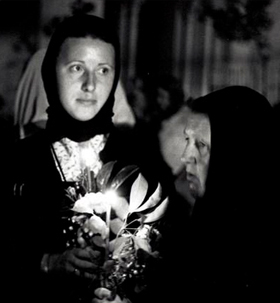Sacred Sites in Contested Regions is a research project that  emerged following a long and fruitful collaboration between us; Prof. Nurit Stadler from the Hebrew University of Jerusalem and Prof. Nimrod Luz from Kinneret College on the Sea of Galilee. ‘Sacred Places’ is a developing product and process of our joint research interests, indeed passion, revolving around religious phenomena, sacred landscapes and transformations in sacred sites in contemporary societies. We come from different perspectives, anthropology of religion (Stadler) and cultural geography (Luz), but in this project and our on-going collaboration we opened up new ways of thinking religion and religiosity which we find highly productive. We were fortunate to discover that others (both colleagues and the general public) are also interested in our work and thus the idea of this site emerged as a way to share our work and promote future collaborations and dialogues.
emerged following a long and fruitful collaboration between us; Prof. Nurit Stadler from the Hebrew University of Jerusalem and Prof. Nimrod Luz from Kinneret College on the Sea of Galilee. ‘Sacred Places’ is a developing product and process of our joint research interests, indeed passion, revolving around religious phenomena, sacred landscapes and transformations in sacred sites in contemporary societies. We come from different perspectives, anthropology of religion (Stadler) and cultural geography (Luz), but in this project and our on-going collaboration we opened up new ways of thinking religion and religiosity which we find highly productive. We were fortunate to discover that others (both colleagues and the general public) are also interested in our work and thus the idea of this site emerged as a way to share our work and promote future collaborations and dialogues.
The project focuses on newly emerging and revived sacred sites on the social and/or spatial margins in contemporary Israel/Palestine. The research objectives are to explore new religious, social, cultural and surely political phenomena as manifested in these developing sites and to explore the ways they mirror present conflicts and meanings. In this project we look at our various sites within the context of social resistance, local political wrangling, cultural innovation, identity politics, collective and individual memory and the ways they challenge the dominant landscape(s). We are exploring and following sacred places as they remerge and re-inscribed into contemporary landscapes. We hold these events as part of ‘our’ places “process of becoming” which constitute a unique opportunity for discovering how specific meanings and practices are articulated, contested, and negotiated by and between religious or ethnic groups and the traditional institutions in the context of the modern state.
In this multi-sited project we wish to understand and focus on the ways in which belief systems are changing, influencing and embedded in the sacred landscape(s). In each of the sites, we examine numerous topics among them: the manner in which devotees and other players reconstruct the features of the site; their criticism and redefinition of religiosity; the ways different religious groups approach the same site, the politics of the changing cultural sacred landscape. Our analysis combines several methods: in-depth interviews with pilgrims, visitors, and ‘various impresarios’; textual analysis of books, manuals, newspaper articles, religious decrees, official public statements and more; participant observations on regular and special occasions; analyses of visual content (i.e., DVDs, films, photos, and maps).
Following our objective to develop a comparative methodology and theoretical framework for studying emerging Christian, Jewish, and Muslim shrines in Israel/Palestine we wish to shed light on four major analytic issues that pertain mainly to the fields of sociology, anthropology, and geography of religion:

· Religious revival: The past few decades have borne witness to new forms of spiritualism, piety, charismatic groups, and syncretism as well as wide-scale conversion and radical interpretations of scripture.
· Comparative religion: Building on the existing research, our objective is to illuminate comparable elements of enchanted places in Israel within the context of the country’s socio-political life. By comparing a horde of Muslim, Christian, and Jewish sites, we hope to remove some of the ambiguity surrounding the creation of sacred places.
· The political and contested nature of holy sites: Following recent discussions in cultural geography and anthropology of religion on the contested nature of sacred places our comparative analysis promises to shed light on the friction, factionalism, and antipathy within and between assorted religious groups as well as the impact of this strife on their culture and belief systems.
· Exploring Religious landscape: our exploration into types of worship and transformations in sacred places in Israel wishes to further our understanding in theoretical discussion on the nature of religious landscape as a socio-political medium. Following we want to add to current discussions concerning the impact of these sites on different aspects of Israeli society.
Our ultimate goal is to allow better access to scholars and laypersons alike to the lives and meanings assigned to and fought over in the plethora of sacred sites we study, explore and analyze. We invite you to explore it, write to us, comment, suggest new ideas and surely enjoy our work.